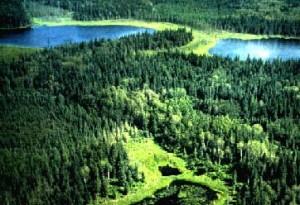Four New Technologies Show Promise for Preserving Wildlife in Canada’s Boreal Forest
 NineSigma, Inc., the leading innovation partner to organizations worldwide, today announced it has helped the Oil Sands Leadership Initiative (OSLI) to identify four promising mammal counting technologies. OSLI is looking for improved methods of counting and identifying mammals in the Boreal Forest in Alberta, Canada, where oil sands operations are concentrated.
NineSigma, Inc., the leading innovation partner to organizations worldwide, today announced it has helped the Oil Sands Leadership Initiative (OSLI) to identify four promising mammal counting technologies. OSLI is looking for improved methods of counting and identifying mammals in the Boreal Forest in Alberta, Canada, where oil sands operations are concentrated.
OSLI is a collaborative network of companies that includes ConocoPhillips Canada, Nexen Inc., Shell Canada, Statoil Canada, Suncor Energy Inc., and Total E&P Canada Ltd., who are sharing research and best practices for preserving the Canadian oil sands. OSLI partnered with NineSigma to identify new technologies for tracking hoofed mammals like moose, caribou, deer, and wood bison, as well as large predators like wolves. These animals are an important part of the health and survival of the region’s ecosystem. The goal is to implement a world-class approach to assuring environmental sustainability, social well-being and economic viability in Alberta’s Boreal Forest, while also providing the world with oil for energy.
NineSigma is the most experienced innovation service provider in the world, specializing in open innovation to solve the world’s most complex challenges. NineSigma’s team of PhD scientists and consultants works closely with its clients to tap the “global brain” of solution providers, who are often from different industries or regions of the world.
“The Canadian oil sands are a valuable natural resource, and we are proud to be part of OSLI’s commitment to ensuring the long-term viability of wildlife indigenous to that region,” said Andy Zynga, CEO of NineSigma.
To date, organizations like OSLI have used cameras, scat detection dogs, visual aerial surveys and collaring with GPS/telemetry units to count large mammals. OSLI is seeking new approaches that utilize advanced technologies to ensure accurate counts and determine if there are issues with animal populations and whether or not mitigation programs are working effectively.
To find better solutions, OSLI engaged with NineSigma to put out a Request for Proposal (RFP) entitled Accurate Wildlife Detection to Determine Absolute Abundance. Selection criteria included strong scientific and technical merit, economic potential, little to no stress on animals, and cost effectiveness, among others. Solutions were welcomed from diverse types of organizations – small to large companies, NGOs or governments, academic researchers, consultants, venture capitalists, entrepreneurs, and inventors. NineSigma vetted entries together with OSLI, and the top four technologies were funded for testing. These winning solutions from the U.S. and Europe include:
– Improvement of current forward-looking Infrared (FLIR) technology.
– Military technology combined with Light Detection and Range (LIDAR), an optical remote-sensing technology that can measure distance or other properties of a target using laser pulses.
– Multi-spectral imaging including polarized light, involving highly refined camera hardware.
– Unmanned aerial vehicles or drones.
“We are making great progress in our goals to improve accuracy, timeliness and economic factors in mammal tracking by seeing these top technologies in action,” says Will Hughesman, Nexen, Land Stewardship Working Group Chair for OSLI. “These technologies could advance the management of industrial impacts on wildlife while enabling safer extraction and provisioning of oil as a viable global energy resource.”


















